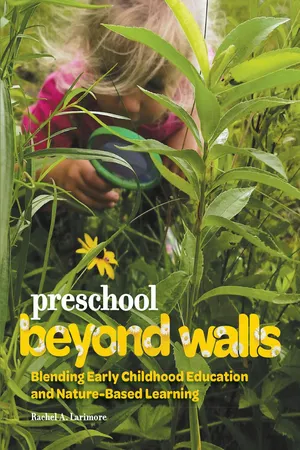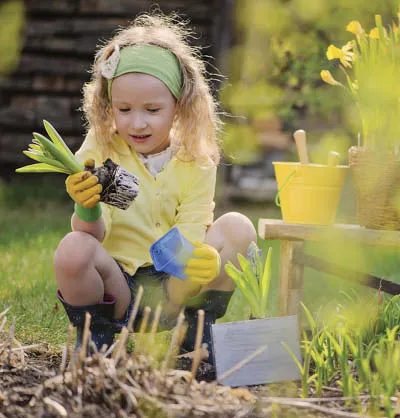
eBook - ePub
Preschool Beyond Walls
Blending Early Learning Childhood Education and Nature-Based Learning
Rachel A. Larimore
This is a test
- 128 pages
- English
- ePUB (mobile friendly)
- Available on iOS & Android
eBook - ePub
Preschool Beyond Walls
Blending Early Learning Childhood Education and Nature-Based Learning
Rachel A. Larimore
Book details
Book preview
Table of contents
Citations
About This Book
Children are spending less timebeing outside in nature, playing, imagining, and learning abouttheir surroundings. Instead, they're spending more time with tablets, televisions, and overly structured routines. Preschool Beyond Walls shows practical and strategic ways educators can create rich, explorative, and interdisciplinary learning through extensive outdoor experiences.
Learn how to develop and implementa nature-based curriculum to supportchildren's optimal learning, from start tofinish. Whether you're creating a new curriculum or transitioning from a traditional approach, you will learn how to:
- Create a program philosophy
- Infuse nature into all aspects of your program
- Prepare teachers for a nature-centered approach
- Implement curriculum and pedagogy that emphasize inquiry-based learning through play and hands-on discovery
- Maintain high-quality early childhood practices that support children's development
Frequently asked questions
At the moment all of our mobile-responsive ePub books are available to download via the app. Most of our PDFs are also available to download and we're working on making the final remaining ones downloadable now. Learn more here.
Both plans give you full access to the library and all of Perlego’s features. The only differences are the price and subscription period: With the annual plan you’ll save around 30% compared to 12 months on the monthly plan.
We are an online textbook subscription service, where you can get access to an entire online library for less than the price of a single book per month. With over 1 million books across 1000+ topics, we’ve got you covered! Learn more here.
Look out for the read-aloud symbol on your next book to see if you can listen to it. The read-aloud tool reads text aloud for you, highlighting the text as it is being read. You can pause it, speed it up and slow it down. Learn more here.
Yes, you can access Preschool Beyond Walls by Rachel A. Larimore in PDF and/or ePUB format, as well as other popular books in Education & Early Childhood Education. We have over one million books available in our catalogue for you to explore.
Information
Topic
EducationSubtopic
Early Childhood Education
Part I:
Laying the Foundation
This first section of the book lays the foundation for the nature-based approach. First, we discuss exactly what is meant by nature-based preschool, so we know what we are moving toward. Second, to be effective in implementing anything new in the classroom, it’s vital to understand the “why” behind those changes. We discuss the underpinning philosophy and pedagogy of the nature-based approach. We then conclude this section with a discussion of the practical concerns of implementing this approach while adhering to licensing regulations and ensuring children’s safety.
Chapter 1:
What Is a Nature-Based Preschool?
Nature-based preschools (NBPs) are part of a broader category known as nature-based early childhood education (NbECE), which refers to any program that combines practices from early childhood education and environmental education. There are a variety of programs within NbECE, but this book focuses solely on NBPs, which fully integrate the best practices of each discipline into a unique pedagogy. The result is an approach much greater than the sum of its parts.
Given the benefits children reap from nature, in my ideal world every preschool would be a full-fledged NBP. While I may be more optimistic about changing the world than some, I am not completely naïve. I realize this is not a realistic goal. I do believe a realistic goal is moving all programs toward full integration.
Almost any program providing early childhood programming is somewhere on a continuum of integrating nature. You may, for example, bring interesting plants and animals into your classroom for the children to examine. You probably provide books about nature, including informational texts on everything from trees to grass to water to birds to unique ecosystems like tallgrass prairies or coral reefs. You may take the children on field trips to local parks or to a zoo. If so, that’s great! This book is primarily focused on helping you move your program even further along the continuum toward becoming an NBP than you already are. However, before moving into suggestions for changing current practices, it’s important to first understand early childhood education and environmental education as separate disciplines and then to see how those disciplines are integrated.
Where Early Childhood Education and Environmental Education Meet
The first eight years of a child’s life is a period of incredible cognitive, physical, social-emotional, and spiritual development. Teaching in early childhood is guided by developmentally appropriate practice, as outlined by Carol Copple and Sue Bredekamp, which emphasizes learning through play. Many programs utilize an emergent-curriculum approach, in which teachers plan activities and projects based on the interests, needs, and skills of the specific group of children they are working with. Supporting the love of learning, curiosity, and sense of wonder early on is critical for children’s happiness and lifelong success. There is mounting evidence that play-based, child-centered approaches to early childhood education support later academic success. The good news is that the NBP approach is rooted in a play-based, emergent curriculum that emphasizes discovery and wonder!
Environmental education (EE), broadly speaking, is focused on developing individuals who are stewards of the planet. To accomplish this goal, EE includes knowledge, skills, and emotional connections to lead to pro-environmental behaviors. EE in the early years focuses primarily on discovery and wonder about the natural world; builds individuals’ comfort outdoors; and lays the foundation for a lifelong connection with the natural world—helping children develop pro-environmental behaviors.
Where the disciplines of early childhood and environmental education meet is NbECE. This type of experience is much more than an early childhood program that happens to meet outside. Learning is not just occurring in nature, but nature is infused into all aspects of learning and central to the pedagogy. NbECE programs include full-time, outdoor programs such as forest kindergartens and waldkindergartens, as well as NBPs. This book is focused on developing NBPs. While there are many possibilities for the structure and operation of an NBP, my goal is to outline what I believe is the ideal NBP so that, wherever your starting point is, you can move toward that approach.
So what makes an NBP different from a traditional preschool? Historically, NBPs were primarily housed at nature centers, but the variety of business structures is constantly growing. There are farm-based programs, programs at universities, programs at zoos, public-private partnerships, and much more. In the end, what is most important is not the administrative or financial structure but the pedagogy within the program.
NBPs fully integrate the best practices of early childhood education with the best practices of EE. They are a type of licensed program for three- to five-year-olds, with at least 30 percent of each class day (whether it is part- or full-day) held outside. Nature is the driving theme and is infused into all parts of the experience. Claire Warden, author of Learning with Nature, refers to the spaces at an NBP as the indoors, the outdoors, and what she calls “the beyond”: the natural areas away from the school. NBPs emphasize building relationships with the natural world through extensive daily outdoor experiences and whole-child development through a child-centered, emergent curriculum that focuses on nature.
Pedagogy of Nature-Based Preschools: An Overview
Being operated by a nature center does not make a preschool nature based. Having a preschool near a natural area does not necessarily make it nature based either. Having an outdoor play area with some natural materials also does not make a program nature based. So what does? The key to a nature-based approach is the day-to-day program practices—both structure and process—which come together to create the nature-based pedagogy. This means any program, if intentional about teaching and administrative practices, can be nature based. In other words, your program can be nature based as well!
Goals
NBPs have two primary goals: educating children in developmentally appropriate ways and teaching environmental stewardship. This means we want to support young children’s development in all domains: physical, social-emotional, and cognitive. This includes the subdomains within these areas, such as spiritual and aesthetic development. At the same time, NBPs strive to develop children’s meaningful connection with the natural world, laying the foundation for the development of environmentally sustainable behaviors. For a nature-based approach, the connection to the natural world is not just one of many child development goals, but one of the most significant. After all, it’s this blending of the two disciplines—early childhood and environmental education—that creates NbECE.
Learning Spaces
Regular access to the physical environment is the first critical component to the NBP approach, and the structure of that physical space is the second. In an NBP, learning occurs indoors, outdoors in a natural play area, and in wilder spaces beyond the play area—inside, outside, and beyond. To illustrate, imagine for a moment this preschool.
As they arrive at school, the parents and children each sign in for the day in ways appropriate for their ages, deposit backpacks in the children’s cubbies indoors, and then head outside to join the teachers. They slowly meander along a curvy, wooded path, fallen leaves crunching underfoot, as they make their way to the outdoor play area. There they are greeted by smiling teachers dressed in hats, mittens, and core layers. Children spot their friends at favorite spots like the sandbox, mud kitchen, digging hill, or other natural elements. With a quick “Bye!” to her parents, the newest arrival runs off to join her friends, rain suit swishing as she moves. Loose parts, such as sticks, buckets, and PVC pipes, become ramps, forts, traps to capture bad guys, and more. Teachers join in the fun, either playing alongside the children or joining as partners in play.
After about an hour, a teacher moves around the play area informing the children that play will wrap up in five more minutes. Children scurry to fill as much fun as they can into those minutes before the teacher shakes the squirrel call, signaling everyone to meet at the stump circle. Each person claims a stump as part of the group circle.
One teacher officially welcomes each student, acknowledging guests who have joined the class for the day and wishing well those students who are absent. After the welcome, the teacher leans into the circle and excitedly whispers, “Guess where we’re ...
Table of contents
- Dedication
- Introduction
- Part I:
- Chapter 1:
- Chapter 2:
- Chapter 3:
- Part II:
- Chapter 5:
- Chapter 6:
- Chapter 7:
- Part III:
- Chapter 8:
- Chapter 9:
- Appendix A:
- Appendix B:
- Appendix C:
- References and Recommended Reading